Basha people
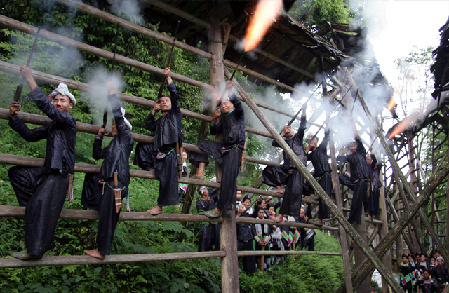
Basha people belong to a branch of the Miao ethnic minority in Guizhou province and have a reputation as the last tribe of gunman. Almost every man above the age of 14 carries a gun and a knife, which they regard as a sign of bravery and honor.
Their ancestor, they believe, is Emperor Chiwu, a legendary warrior who engaged in fighting with the Yellow Emperor. They have spoken – not written – language.
The inhabitants share a worship of trees as they believe their life has been blessed by the God of Trees. In addition, most major festivals and events are held in the trees. If people get married, the witness is two intertwining trees.

When a baby is born, the elders will plant a tree for them. When people die, a tree will be cut down and made into a coffin which continues to stay with their owners. The tome is quite austere, with only a new tree planted on the ground beneath which the dead are buried.
There are less than 1,000 people living in the tribe now, but their customs, thanks to the surrounding mountains, have remained what they were thousands of years ago -- a trait which has become more valuable in an increasingly modern society.
Ewenki People
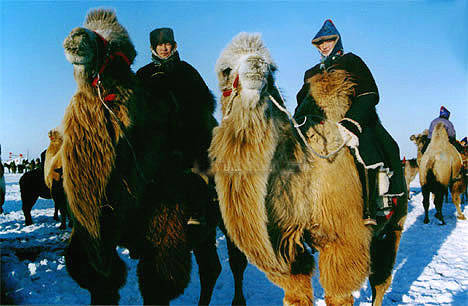
When Christmas comes, Santa Claus would fly around the world in a sleigh pulled by magical flying reindeer. In the depths of the primeval forest in northeast China, reindeer abound, as does a semi-nomadic tribe that is regarded as the last tribe of hunters – the Ewenki people.
Since they have to hunt and feed the reindeer, they have no fixed houses. They use pine wood to pitch a tent, called Cuoluozi, as they move around in the forests.
According to their tradition, people in the same clan cannot get married and they have to choose someone from other clans or tribes. When people decide to tie the knot, the girl has to flee to the boy’s Cuoluozi; the old women will braid her hair into two pigtails, as opposed to the eight pigtails before they are married.
The Khmus
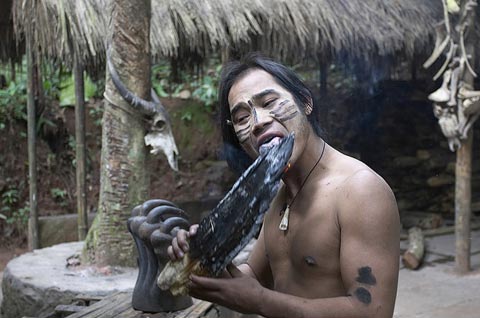
Khmus people are still an ethnic minority that hasn’t been officially named. They mainly live along the borderline between China and Laos. Isolated by the atrocious conditions, the people maintain their way of life as in the clan society.
When the boy and girl decide to get married, the girl will take the boy to her home. If her parents treat the boy with hospitality, it means he is accepted, but if they ask the boy, ‘What are you doing here?’ the romantic relationship ends.
Changganhu people

Changganhu people have a reputation as the last tribe of fishers that continue to catch fish using ancient methods. Though well known in China, they remain associated with mystique for their customs.
The first event is the worship of the Changan Lake. Before they start winter fishing, they will hold rituals to offer sacrifice to heaven, earth and the lake, displaying their gratitude to the blessed life.
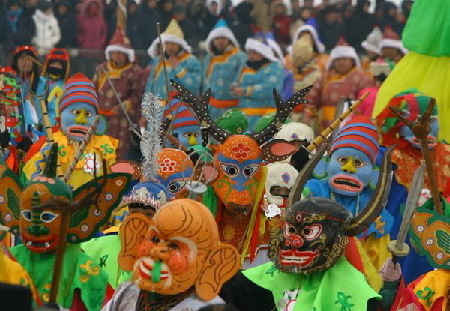
The other spectacle is the huge fishnet, about 2,000 meters long. The job is controlled by experienced fishers who can easily see where the fish gather. They dig over 400 holes and put the net beneath the half-meter-thick ice, which circles the fish and brings them a fishing bonanza.
Foot-binding Women in Liuyi Village
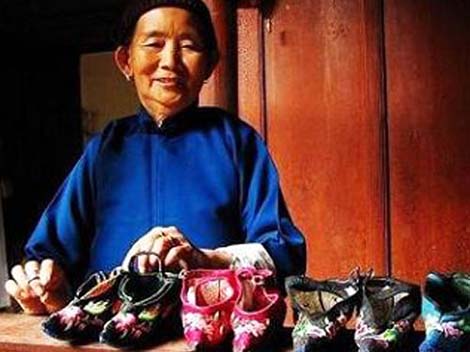
Liuyi Village lies to the south of Kunming, the capital of Yun’nan province. Known for its 300 foot-binding women, the village has become the last representative of the notorious federal practice.
Foot-binding women can be easily seen in the small village. Most of them began to bind their feet in the 1940s when China was experiencing political turmoil and people become intellectually enlightened. When the P.R.C was established in 1949, they decide to liberate their feet, but with years of physical damage, the hurt has become something that cannot be mended.
Mosuo People
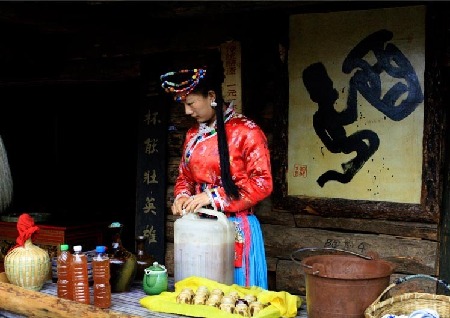
In China, the Mosuo ethnic minority is the best presentation of a matriarchal society.
When you visit a Mosuo family, the hostess greets you in most cases while the man will have small talk with you. Women have absolute power in the community.
Theoretically, husband and father are not in the dictionary of the Mosuo people since they share walking marriage -- a unique tradition in which women invite men to visit their rooms at night and then to leave in the morning. Children of these "walking marriages" remain in their mother’s homes from the moment they are born.
It is not sexual liberation and wanton lust. There are strict traditional rules governing the custom. Most Mosuo women don't change walking-marriage partners very frequently and they rarely carry on more than one romantic relationship at a time. In addition, people in the same family lineage are not allowed to be engaged in romance.
Mishmi people

Deng people, also known as Mishmi people, are the smallest ethnic minority living in Tibet by population.
They once lived in the depths of the mountains and led a primitive and austere life.
According to their tradition, women are not allowed to eat pork, beef and chicken from the age of eight, otherwise they will be condemned by the whole community. When they give birth to three or four babies, the prohibition will be lifted.
Knives play an important role in their daily life. They can be used in farming, hunting and protecting themselves in case of emergency.
Their leader is the only one in China allowed to carry a knife while boarding a plane or having meeting in the Great Hall of the People – a venue used for legislative and ceremonial activities by the People's Republic of China and the Communist Party of China.
Axi People
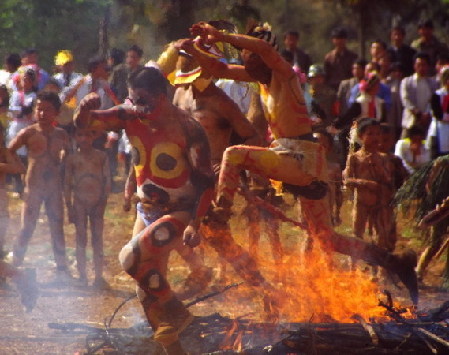
Axi, is a branch of the Yi ethnic minority in Yunnan province. The people there share a worship of fire as a natural blessing. Every Feb 3 in the Chinese lunar calendar, they will hold grand rituals to offer sacrifices to the God of Fire.
The grown-up men and the children will disguise themselves respectively with patterns which are symbols of local animals and plants. They are almost naked, with palm leaves or linen covering their productive organs. They sing, yell and dance to express their gratitude to the ancestors and their eulogy to the blessed life.
The Last Cave Dweller

Rich in ethnic tradition and geographical resources, Guizhou in southwest China is familiarly known as an ethnic museum.
The Miao people’s village of Zhongdong -- which literally means "middle cave" -- is built in a huge, aircraft hanger-sized natural cave, carved inside a mountain over thousands of years by wind, water and seismic shifts.
In other parts of China, people live in houses tunneled out of hillsides, but Zhongdong is, the local government believes, the last place in the country where people live year-round in a naturally occurring cave.
The villagers are all ethnic Miao people, supposedly related to Southeast Asia's Hmong, and one of several minority groups who live in Guizhou.
Hezhe People
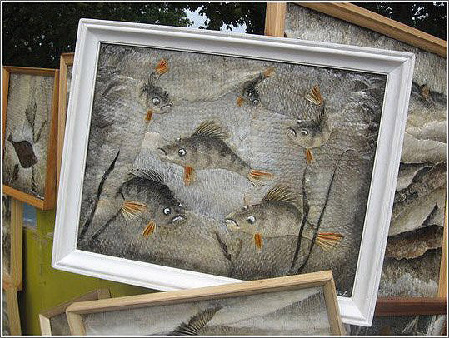
An ancient and hard-working ethnic group, the Hezhe ethnic minority is a small member in the 56 ethnic groups of the Peoples Republic of China. They mainly live on the border between China and Russia.
The Hezhe people are the only ones who live on fishing and driving a sledge with dogs in northern China. The fishing industry is the main source of livelihood for most Hezhes. Old and young, male and female, they are all good at fishing. They have gained superb skills and knowledge in fishing through time-tested experience.
Hunting is another source of income for the Hezhes. Nowadays, they are also engaged in agriculture and aquatic-breeding.





